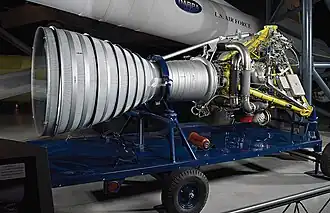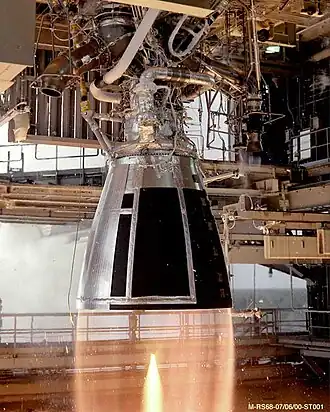Rocketdyne S-3D
 S-3D engine at the National Air and Space Museum | |
| Country of origin | United States |
|---|---|
| Manufacturer | Rocketdyne |
| Application | Booster |
| Successor | H-1 |
| Status | Retired |
| Liquid-fuel engine | |
| Propellant | LOX / RP-1 |
| Cycle | Gas Generator |
| Configuration | |
| Chamber | 1 |
| Performance | |
| Thrust, sea-level | 134908 lbf (600.1 kN) |
| Specific impulse, sea-level | 247 seconds (2.42 km/s) |
| Used in | |
| PGM-19 Jupiter, PGM-17 Thor, Juno II, Saturn A-2 | |
The Rocketdyne S-3D (Air Force designation LR79)[1][2] is an American liquid rocket engine produced by Rocketdyne (a division of North American Aviation) between 1956 and 1961. It was a gas generator, pump-fed engine, using a liquid oxygen (LOX) and RP-1 (kerosene) propellant combination, capable of producing 134,908 pounds of thrust (600.1 kN) at sea level.[3]
The S-3 was based on the Redstone engine,[4] and is part of the LR79 family,[5][6][1][2] used on the PGM-19 Jupiter and PGM-17 Thor missiles,[7][4][8] and on the Juno II rocket.[3][9][10][11]
A second stage with four S-3 engines was considered for the Saturn A-2 study.[12]

Its design was used later as the basis for the H-1 rocket engine of the Saturn I,[13][1][7] and the Rolls-Royce RZ.2 of the Blue Streak.
Specifications
Rocketdyne S-3D:[3]
- First flight: 1957
- Vehicles: PGM-19 Jupiter
- Thrust: 600.1 kN (134908 lbf).
- Specific impulse: 282 s.
- Burn time: 247 s.
Rocketdyne S-3: [14]
- First flight: 1958
- Vehicles: Juno II, Saturn A-2[12]
- Thrust: 667.2 kN (149993 lbf).
- Specific impulse: 282 s.
- Burn time: 182 s.
- Diameter: 2.67 m (8.75 ft).
- Dry mass: 725 kg (1,598 lb)
References
- ^ a b c "S-3D/LR-79 Engine". heroicrelics.org. Retrieved 2024-10-28.
- ^ a b "Rocketdyne LR79 Rocket Engine". National Museum of the United States Air Force.
- ^ a b c Wade, Mark. "S-3D". Encyclopedia Astronautica. Archived from the original on November 7, 2016.
- ^ a b "Jupiter S-3 Rocket Engine | National Air and Space Museum". airandspace.si.edu. Retrieved 2024-10-28.
- ^ Wade, Mark. "LR79". Encyclopedia Astronautica. Retrieved 2024-07-29.
- ^ "Rocketdyne LR79". National Museum of the U.S. Air Force.
- ^ a b Bilstein, Roger E. (1996). Stages to Saturn: A Technological History of the Apollo/Saturn Launch Vehicles. National Aeronautics and Space Administration, NASA History Office. pp. 29, 142. ISBN 978-0-16-048909-9.
- ^ "Jupiter Family". Gunter's Space Page. Retrieved 2024-10-28.
- ^ Wade, Mark. "Jupiter". Encyclopedia Astronautica. Archived from the original on October 10, 2011.
- ^ "Rocket Engine, Liquid Fuel, S-3D for Jupiter Missile | National Air and Space Museum". airandspace.si.edu. Retrieved 2024-10-28.
- ^ "Juno-2". Gunter's Space Page. Retrieved 2024-10-28.
- ^ a b "Saturn A-2". 2016-12-28. Archived from the original on 2016-12-28. Retrieved 2024-10-28.
- ^ "S-3D Rocket Engine Overview". heroicrelics.org. Retrieved 2024-10-28.
- ^ "S-3". www.astronautix.com. Retrieved 2024-10-28.
